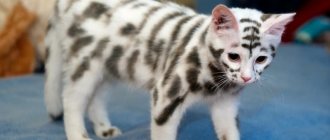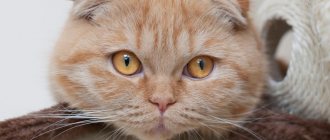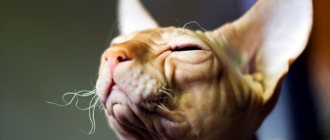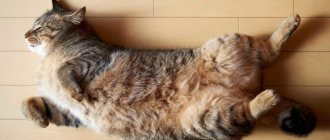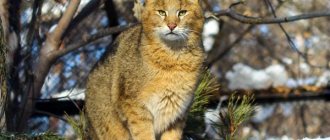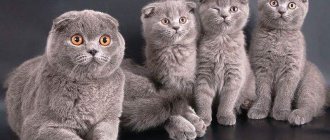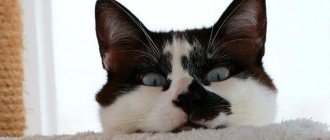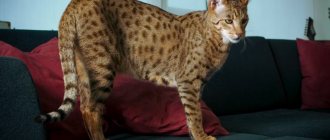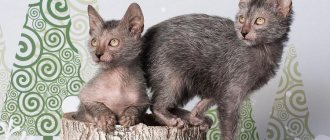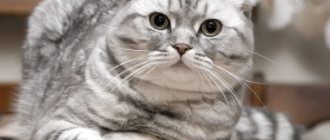- Wild animals
- >>
- Mammals
The snow leopard is an amazing inhabitant of the mountains, a predatory, dexterous, and very graceful animal. The animal is not called snow for nothing. This is the only representative of the cat family that lives in the mountains, where there is snow all year round. The predator is also called the snow leopard, the lord of the mountains or the snow leopard.
In ancient times, due to the similarity of appearance, they were called snow leopards, and were even considered representatives of the same species. However, snow leopards are not related to leopards. They are much stronger and faster, although they are inferior in size. Unfortunately, today this incredibly beautiful predator is on the verge of complete extinction.
Origin of the species and description
Photo: Snow Leopard
Snow leopards are representatives of predatory mammals. They belong to the cat family, separated into the genus and species of snow leopards. The theory of the origin of this amazing and very graceful predator has not yet been formed.
Back at the end of the 16th century, Russian fur traders and artisans heard from Turkic hunters about a mysterious handsome man, whom they called “irbiz”. For the first time, European residents were able to see the strange cat in 1761. Researcher Georges Buffon showed European nobility pictures that depicted a very beautiful wild cat. He supplemented his pictures with information that they are trained and raised to participate in hunting in Persia.
Video: Irbis
Since then, many scientific researchers and zoologists have been interested in this amazing beast. In 1775, the German zoologist-naturalist Johann Schreber wrote an entire scientific work that was devoted to the origin and evolution of animals, as well as a description of their appearance and lifestyle. Subsequently, the Russian scientist Nikolai Przhevalsky also studied the life activity of the snow leopard. A number of scientific, including genetic, examinations were carried out, according to which it was possible to establish that the approximate existence of the feline predator is about one and a half million years.
The first remains of the animal, which by all indications belonged to the snow leopard, were discovered on the western border of Mongolia, in Altai. They are dated to the late Pleistocene period. The next significant find is the remains of an animal in the northern region of Pakistan. Their approximate age is one and a half million years. Initially, snow leopards were classified as panthers. A little later, studies showed that the snow leopard and the panther do not have direct common characteristics.
This representative of the cat family has distinctive features that are not inherent in other representatives of this family. This gives grounds to distinguish them into a separate genus and species. Although today there is no exact information about the origin of the snow leopard genus, scientists are inclined to believe that the snow leopard and the panther did not have common ancestors. The results of genetic testing give reason to believe that they separated into a separate branch a little more than a million years ago.
How to choose a kitten
Bengal cat on owner's lap
Let us remind you once again: the Bengal cat is an elite, and therefore expensive, breed. You should not look for advertisements for the sale of kittens on random sites or, especially, buy an animal at the “bird market”. Only reliable nurseries or breeders with an excellent reputation can guarantee that your pet will be a real Bengal with a reliable pedigree!
When purchasing a kitten, pay attention to
- registration documents, pedigree and the generation indicated in it (optimal indicator F4-F7);
- age – a responsible breeder does not offer buyers kittens younger than 10-12 weeks;
- weight – at this age, a normally developing baby weighs about a kilogram;
- playfulness - a healthy animal should never be lethargic;
- contact - small Bengals must be accustomed to being handled, otherwise you risk getting a wild pet;
- clean and clear eyes, no runny nose or signs of diarrhea;
- documents on vaccination;
- the condition of the coat and the absence of visible color defects (important if the Bengal cat is planned to participate in exhibitions).
Appearance and features
Photo: Animal snow leopard
The snow leopard is an animal of incredible beauty and grace. The body length of one adult individual is 1-1.4 meters. The animals have a very long tail, the length of which is equal to the length of the body. Tail length is 0.8-1 meter. The tail plays a very important role. Animals use it to maintain balance in mountainous areas and to warm their front and hind paws in snow and frost. The weight of one adult individual is 30-50 kilograms.
Sexual dimorphism is not expressed, but males are slightly larger than females. Predators have large front paws with round pads measuring 1*1 cm. Long hind feet ensure fast movement among mountain peaks and deft, graceful jumps. The limbs are not very long, but the paws are thick and powerful. The paws have retractable claws. Thanks to this, there are no traces of claws left in the snow where the graceful predator passed.
The feline predator has a round head, but with small, triangular ears. In winter, in thick, long fur, they are practically invisible. Animals have very expressive, round eyes. The snow leopard has long, thin whiskers. Their length reaches just over ten centimeters.
Interesting fact. The snow leopard has very long and thick fur, which keeps it warm in harsh climates. The length of the coat reaches 50-60 centimeters.
The area of the spinal column and the lateral surface of the body are gray, close to white. The abdominal area, inner surface of the limbs and lower abdomen have a lighter tone. The unique color is provided by ring-shaped dark, almost black rings. Inside these rings are smaller rings. The smallest circles are located in the head area. Gradually, from the head, along the neck and body to the tail, the size increases.
The largest rings are located in the neck and limbs. On the area of the back and tail, the rings merge, forming transverse stripes. The tip of the tail is always black. The color of winter fur is smoky gray with an orange tint. This color allows them to remain unnoticed by steep rocks and snowdrifts. By summer, the coat becomes light, almost white.
Appearance of the breed
Bengal cats are medium to large in size, but are inferior to the largest domestic breeds such as the Maine Coon or Savannah.
The weight of an adult animal can range from 4 to 9 kg, height at the withers - 26-32 cm, length from nose to tip of tail - 65-100 cm. Moreover, males are much larger than females and reach their maximum size by 2 years. Cats practically stop growing after 9 months. The main distinguishing feature of the Bengal cat's exterior is undoubtedly its “wild” color; it was this feature that determined the direction of breeding work from the very beginning. Over time, a breed standard was developed and approved that covers the main traits.
Wool
The Bengal cat's coat is shorter than average (medium length is acceptable for kittens), thick, and close to the body. A characteristic difference from other breeds is their extraordinary silkiness and special “internal” shine, called glitter. The latter is inherited from wild ancestors and is extremely valued.
Color
Bengal cat face
The main requirement for the color of a Bengal cat is the clearest possible contrast between the spotted or marbled pattern and the background. The design can range from black to cinnamon, and the background should be between golden orange and ivory. Reputable breeders (for example, Jean Dakota) insist that preference should be given not to “red” Bengals, in which, as they grow older, the rosettes and stripes almost merge with the base, but to cats with a fawn background and a dark pattern.
Due to the “wild” genes, Bengal kittens have a unique color feature for domestic cats: when born bright, with a pronounced pattern, they suddenly fade by 3-4 weeks. This is explained by the fact that at this age the offspring of the Far Eastern cat begins to leave their safe shelter and without such “tarnishing” they will become easy prey for predators. This fuzzing (from the English fuzzy - blurry, indefinite) lasts about two months, that is, just by the time the kitten is purchased, it becomes attractive again. However, the final color of a cat is established much later, at 8–10 months.
The spotted pattern is more common than the marbled pattern. What distinguishes them from the usual “mackerel” color for other breeds is their location along (and not across) the body or diagonally. The shape of the spots can vary widely, the main thing is their clear outlines, while simple single ones are considered undesirable. Marble pattern - contrasting stripes whirling in a horizontal direction. A significant disadvantage of any color is the white spots - “medallions” on any part of the body. The belly is preferably light in color and the absence of spots on it is sufficient to disqualify a Bengal cat for exhibition.
Today, the officially accepted varieties are brown tabby, silver tabby, seal sepia tabby, seal mink tabby, seal lynx point and, approved only in 2013, and therefore rare blue tabby.
Adult Bengal cat with kitten
Head
Bengal on a box
The structure of the Bengal cat's skull belongs to the so-called “wild” type. It has the shape of a modified wedge, elongated rather than wide, the contours are soft and rounded. The line of the occipital part is a continuation of the line of the neck. In relation to the body it has a small, but generally proportional size.
Regarding the profile, there are differences between the American and European standard. The first assumes a strictly straight line forming a single arc from the level of the eyebrows, while the second allows for the possibility of a slight bend at the junction of the forehead and nose.
The jaws are powerful. The cheekbones are high and clearly defined. The chin is rounded, located in line with the tip of the nose. Adults may have prominent cheeks. The nose is large and wide. The whisker pads are convex.
Ears
They continue the wedge line, are characterized by a small size in relation to the head, a wide base and rounded tips (most other breeds have pointed tips).
Eyes
The eyes of a Bengal cat are large and expressive. The shape is oval, but close to round. They are spaced quite wide and have a deep seat. The color is bright and rich, most often ranging from light green to gold. Point and mink cats have shades of blue and blue from aqua to sapphire. They glow very brightly in the dark.
Bengal with blue eyes
Neck
Mmm... shrimp
Corresponds to the proportions of the head and body. Long, strong, muscular.
Torso
It has developed muscles, powerful, elongated (but not the oriental type, characteristic of orientals). The skeleton is solid and strong. A flattened or underdeveloped chest is a disqualifying fault.
Limbs
Medium length, strong, muscles developed in proportion to the general constitution of the body, wide bones. The hind ones are slightly longer than the front ones. The pads are large, round in shape, and the finger joints protrude slightly.
Tail
The Bengal cat's tail is of medium length, thick, tapering towards the end and has a rounded tip. Ringed with dark stripes or (less commonly) covered with small spots.
Where does the snow leopard live?
Photo: Snow leopard in Russia
Animals live only in mountainous areas. The average altitude of its permanent habitat is 3000 meters above sea level. However, in search of food, they can easily climb to a height twice as high as this figure. In general, the snow leopard's habitat is very diverse. The largest number of animals is concentrated in the countries of Central Asia.
Geographical regions of snow leopard habitat:
- Mongolia;
- Afghanistan;
- Kyrgyzstan;
- Uzbekistan;
- Tajikistan;
- China;
- India;
- Kazakhstan;
- Russia.
In our country, the population of the feline predator is small. They are located mainly in Khakassia, Altai Territory, Tyva, and Krasnoyarsk Territory. The animal lives in mountains such as the Himalayas, Pamirs, Kun-Lun, Sayan Mountains, Hindu Kush, the mountains of Tibet, and many others. Animals also live in protected and protected areas. These include the territory of the Altushinsky and Sayano-Shushensky national parks.
Most often, the predator chooses the territory of steep rock cliffs, deep gorges and bushes as its habitat. Snow leopards prefer regions with low snow cover. In search of food, it can go down to forests, but spends most of its time in mountainous areas. In some regions, snow leopards live at an altitude not exceeding a thousand kilometers above sea level. In regions such as the Turkestan Range, it mainly lives at an altitude of 2.5 thousand meters, and in the Himalayas it climbs to a height of six and a half thousand meters. In winter, they can change their locations depending on the regions where the ungulates live.
The territory of Russia accounts for no more than 2% of the entire habitat of predators. Each adult occupies a special territory, which is prohibited for others.
Features of behavior
The snow leopard animal, as a rule, chooses loneliness. Some individuals live in pairs - a female and a male. Personal territory is marked in various ways, but this is more of a habit than a necessity. The snow leopard is not particularly zealous in protecting it; it reacts calmly to the appearance of females or other males. The size of hunting grounds for individual individuals varies significantly, depending on the region of residence and the amount of prey (the less suitable food, the larger the land). An individual plot can cover an area from 12 km 2 to 160 km 2.
The snow leopard goes hunting at dusk - early in the morning or before sunset. In search of food, the snow leopard sets off along the same route. Looks into camps and pastures of wild ungulates, hunting smaller game along the way. Often such a journey takes several days and the animal has to travel tens of kilometers before returning to its den. The reference point for movement is a stream, river or mountain range.
Deep snow restrains the animal's agility and interferes with hunting. To make his way easier, he has to trample paths in the snow. The routes rarely change; the snow leopard uses the same paths more than once. Such predictability attracts poachers - an unsuspecting predator becomes easy prey for them.
The snow leopard establishes a shelter in rocky heaps, caves, and rock crevices. It settles in a den for several years and selects suitable shelters for a rookery far from home.
What does a snow leopard eat?
Photo: Snow leopard cat
By nature, the snow leopard is a predator. It feeds exclusively on food of meat origin. It can hunt both birds and large ungulates.
What is the food supply:
- Yaks;
- Rams;
- Roe deer;
- Argali;
- Tapirs;
- Serau;
- Boars;
- Musk deer;
- Marmots;
- Gophers;
- Hares;
- Chukars;
- Feathered;
- Rodents;
- Mountain goats.
For one meal, an animal needs 3-4 kilograms of meat to be completely satisfied.
Interesting fact. The snow leopard eats only at home. After a successful hunt, the leopard carries its prey to its den and only eats it there.
The snow leopard is a unique hunter and can kill several victims in one hunt. In summer it can eat berries or various types of vegetation, young shoots. For a successful hunt, the leopard chooses the most convenient position for an ambush. Mainly chooses places near waterfalls where animals come to drink, as well as near paths. Attacks with a sharp, lightning-fast jump from an ambush. The startled animal does not have time to react and becomes the prey of a predator. The leopard usually attacks from a distance of several tens of meters.
It attacks an especially large animal by jumping on its back and immediately biting into the throat, trying to bite or break its neck. The snow leopard, as a rule, has no competitors. It feeds on fresh meat, and leaves what is not eaten to other predators or birds.
During times of famine, he can come down from the mountains and hunt livestock - sheep, sheep, pigs, etc. Birds, rodents and smaller animals are a source of food only when there is an acute shortage of larger animals in the region where predators live.
Nutrition
The snow leopard is a universal hunter . It poses the same danger to yaks, rams, roe deer, as well as to mice, gophers and small birds. The predator's diet consists of fresh meat, preference is given to ungulates, but if hares, pheasants and small rodents come across on the way, it does not refuse them either. The lack of vitamins is compensated in the summer by supplementing the main diet with grass and plant shoots. The daily amount of meat for an adult predator is 2 – 3 kg.
The snow leopard stalks its prey from ambush, hiding near watering holes, trails, or quietly sneaking up on the victim. It attacks several tens of meters from the victim, jumps out sharply and overtakes the hesitant animal with jumps. In case of a miss, he runs 300 meters after the game or, having accepted defeat, goes in search of a new target.
The snow leopard jumps on the back of large animals, grabs them by the throat, strangles them or breaks their neck. The trophy is dragged into a shelter and only there begins the meal, tearing meat from the victim’s skeleton with sharp teeth. Leaves the leftovers from lunch for everyone, eating only fresh food. In its habitat it is out of competition and has no obvious enemies.
Features of character and lifestyle
Photo: Snow leopard Red Book
Snow leopards prefer a solitary lifestyle. Each adult individual chooses a specific habitat, which is prohibited for other representatives of the species. If other individuals of a given family enter the habitat, regardless of gender, they do not show pronounced aggression. The habitat of one individual ranges from 20 to 150 square kilometers.
Each individual marks its territory with marks with a specific smell, as well as claw marks on trees. In conditions of existence in national parks or reserves, where animals are limited in territory, they try to stay at a distance of at least two kilometers from each other. In rare exceptions, snow leopards exist in pairs.
It is most active at night. It goes hunting at dawn or after dark. Most often, he develops a specific route and moves only along it in search of food. The route consists of watering places and ungulate pastures. In the process of covering its route, it does not miss the opportunity to catch smaller food.
The snow leopard has landmarks on each route. These may include waterfalls, rivers, streams, high mountain peaks or rocks. Completing the chosen route takes from one to several days. During this period of time, the predator covers from ten to thirty kilometers.
In winter, when the thickness of the snow cover increases, the predator is forced to first trample its paths in order to be able to hunt. This can play a cruel joke on him, since the trails visible in the snow and the habit of not changing their route make them easy prey for poachers. Animals are capable of developing great speed and, thanks to their long feet, can jump 10-15 meters in length.
Interesting fact: The snow leopard is the only member of the cat family that does not growl. They often make long sounds. This is especially true for females during marriage. With this sound, which is formed by the passage of air masses through the nostrils, females notify males of their location.
This sound is also used as a greeting between individuals. Facial expressions and direct contact are also used as communication. In order to demonstrate strength, animals open their mouths wide, exposing long fangs. If predators are in a good mood and peaceful, they open their mouths slightly without showing fangs, and also wrinkle their noses.
About assumptions and visible shortcomings leading to the rejection of snow individuals by breeders
First, a few words about the assumptions of the standards. A Bengal cat will not be rejected if:
— a grayish undercoat was present;
- the shape of the eyes tends to become almond-shaped;
— the color of the pads on the paws and nose is slightly different from that accepted in a particular color.
Snowy females, while maintaining harmonious proportions, may have smaller dimensions and weight than males. In cats, the jaws (“cheeks”) may visually protrude, but not excessively. Despite the fact that Snow Bengals have genes from the Siamese series, it is desirable for them to have a minimal difference between the main color of the body and the spots, and ideally - a complete absence of difference.
Unforgivable deviations from standards
Inadmissible signs include visually identifiable defects in the appearance of a Bengal cat:
- spots merging into smooth vertical stripes on the body (the so-called tiger pattern);
- Marbled cats have rounded markings that create a “bull’s eye” shape;
- significantly darker range of markings compared to the body;
- any (blurry or clear) whitish medallion spots on the chest, neck, abdomen of the animal;
- partially remaining phasing hair.
Connoisseurs, as well as professional felinologists, rightly believe that the snow coloring of Bengal cats is the most original and very effective. Being the lightest of the entire existing range of Bengal colors, it has the most extensive color palette.
It is in this division that the rarest and actually snow-white Bengals with aquamarine eyes are born. Despite the presence of different bloodlines in their genotypes, Snow Bengals retained increased activity, a love of climbing, and a developed hunting instinct characteristic of their wild ancestors. Therefore, when purchasing an expensive, rare pet, a person will not have a lazy, imposing “show” animal, but an active, boastful pet with the habits of a predator, even if it is a gentle white Bengal cat.
Social structure and reproduction
Photo: Snow leopard cub
Animals tend to lead a solitary lifestyle. Individuals of the opposite sex communicate with each other only during marriage. Females mate once every two years. Animals are naturally monogamous. When existing in captivity or in national parks and protected areas, they can be monogamous.
The period of marriage depends greatly on the time of year. It begins with the onset of winter and lasts until mid-spring. Females attract males by making a long, creaking sound. Males respond to the call. When individuals of different sexes are found in the same territory, they themselves behave more actively. She raises her tail like a pipe and walks around the male. During the mating process, the male holds the female in one position by grabbing the fur near the withers with his teeth. The female's pregnancy lasts 95-115 days. From mid-spring to mid-summer, small kittens appear. Most often, one female is able to reproduce no more than three kittens. In exceptional cases, five kittens may be born. The female leaves to give birth to her babies in the stone gorges.
Interesting fact. The female makes a kind of hole in the gorge, lining its bottom with fur from her belly.
The weight of each newborn kitten is 250-550 grams. Babies are born blind; after 7-10 days their eyes open. They leave the lair after two months. Upon reaching 4-5 months of age, they participate in hunting. Until six months, the mother feeds her babies with breast milk. Upon reaching the age of two months, kittens begin to gradually become familiar with solid, meat foods. Females reach sexual maturity at the age of three years, males at the age of four years. During the first year they maintain the closest possible connection with their mother.
The average lifespan of predators is 13-15 years in natural conditions. In captivity, life expectancy can increase to 27 years.
Reproduction
Snow leopards lead a predominantly solitary lifestyle, but can form family groups. The territory of one male has an area of 150–160 square kilometers. Partially overlapped by female territories. They prefer to settle in rocky places , often occupying natural caves or nests of large birds.
Mating occurs in spring or early summer. The mating season is very short - only a week. Pregnancy lasts 3–3.5 months. The female makes a warm, secluded den, the bottom of which is lined with her fur. There are 2–3 kittens in a litter. The cubs are born blind and their eyes open after about a week. Babies weigh approximately 500 grams and reach a length of 30 centimeters. The color is brown with small spots. At first they feed only on mother's milk. Only the mother takes care of the babies.
The cubs sit in a cave hidden from prying eyes for about 2 months. All this time, in addition to milk, the female feeds them with meat. Little leopards begin to go hunting with their mother at about six months . At first, only the mother rushes to the prey.
Children become independent at about two years of age, and sexual maturity occurs at four years of age. The lifespan of snow leopards reaches 13 years; in captivity they can live up to 20.
Natural enemies of snow leopards
Photo: Big snow leopard
The snow leopard is considered an animal that stands at the very top of the food pyramid and has practically no competitors or enemies. In some cases, interspecific hostility occurs, during which adult, strong individuals die. Enmity between snow leopards and leopards is common. Adult, strong individuals pose a threat to young and immature snow leopards.
The greatest threat is posed by people who kill animals in pursuit of valuable fur. In Asian countries, medicinal products often use skeletal elements as an alternative to tiger bones for making medicines.
Population and species status
Photo: Snow leopard kittens
Today this amazing and very graceful predator is on the verge of complete extinction. This status of this animal species is due to a number of specific reasons. Reasons for the extinction of the species:
- The habitats of individual groups of animals are very remote from each other;
- Slow reproduction rates;
- Depletion of food supply – reduction in the number of artiodactyls;
- Poaching;
- Very late puberty.
According to the World Animal Protection Organization, there are from 3 to 7 thousand individuals in the world. Another 1.5-2 thousand animals exist in zoos and national parks. According to rough statistics, the number of individuals in Russia has decreased by a third over the past decade. The extinction of the species was also facilitated by a sharp reduction in the number of sexually mature females.
Common colors
The color standard for Bengals is strict. A newborn kitten receives an alphanumeric mark indicating the color and type of fur pattern.
The breed designation according to the international classification is BEN.
The color basis of Bengal colors is indicated in Latin letters:
- n – black;
- ns – silver;
- ny – gold.
At the end of the color designation, put the figure number:
- 22 – marble;
- 24 – spots and rosette;
- 31 – snowy sepia;
- 32 – snow minx;
- 33 – snow links.
Separately, there are unrecognized colors that do not have a designation:
- blue;
- coal;
- melanistic.
To determine the color of Bengals by number, you should use the table.
| designation according to international classification | transcript |
| BEN ny 22 | marble gold |
| BEN ny 24 | spotted golden |
| BEN ns 22 | marble silver |
| BEN ns 24 | spotted silver |
| BEN n 31 | sepia |
| BEN n 32 | minx |
| BEN n 33 | links |
| BEN n 24 charcoar | carbonic |
| BEN n 24 melanistic | melanistic |
| BEN a 24 | blue |
Gold and silver colors are the main colors for Bengals. With a golden color, the iris is yellow or yellowish-green, the pads of the paws are brown.
Golden color implies many shades, Bengal can be:
- chocolate;
- ginger;
- chestnut;
- brick;
- beige;
- dark brown;
- light brown.
Silver cats have a cool bluish-gray coat. The pattern is black or rich gray. The undercoat is white or grayish-white, and the belly is similarly colored. The paws and tail are black, and the lobe is reddish-brown. Silver Bengals have yellow or green irises.
Important! Blue-eyed Bengal cats are considered defective and are not allowed for breeding.
